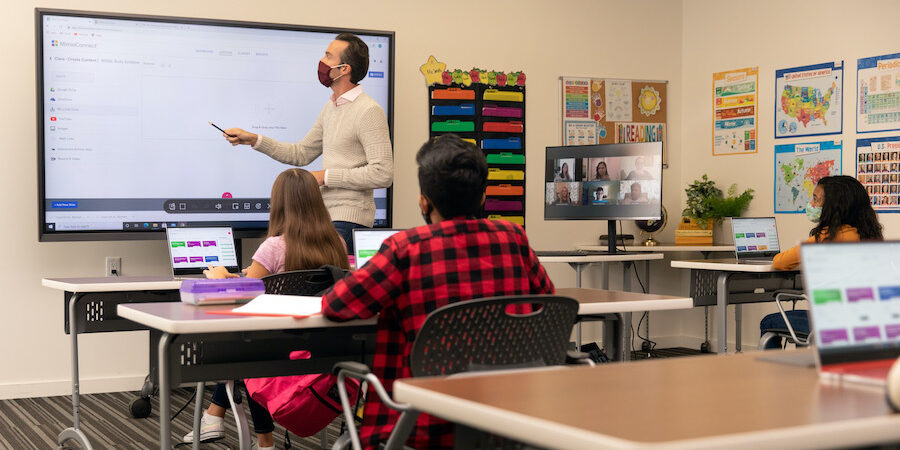The Best Primary Science Tuition Singapore for Effective Learning Methods
The Best Primary Science Tuition Singapore for Effective Learning Methods
Blog Article
A Comprehensive Guide to the Various Discovering Methods in Main Scientific Research Instruction
The expedition of diverse understanding approaches in key science direction presents a possibility for instructors to boost pupil interaction and comprehension dramatically. By analyzing hands-on knowing techniques, inquiry-based methods, and collective techniques, we can identify efficient methods that accommodate various discovering designs. Furthermore, the assimilation of technology and set apart instruction plays an essential function in promoting an inclusive environment. Nevertheless, the concern stays: how can these approaches be properly applied in the classroom to maximize their influence? The solution hinges on a better evaluation of each technique and its effects for mentor scientific research.

Hands-On Knowing Techniques
Hands-on understanding methods play a crucial function in key science instruction, engaging trainees in energetic expedition and testing. These methods allow students to communicate directly with materials and phenomena, fostering a much deeper understanding of clinical ideas. By utilizing manipulatives, models, and real-life experiments, educators produce an atmosphere where students can observe, assume, and test their ideas.
Such techniques not only improve comprehension however also cultivate important reasoning and problem-solving abilities. When trainees join activities like developing basic makers, growing seeds, or performing chemical responses, they are urged to ask inquiries and look for solutions through their very own monitorings. This experiential method aids to demystify intricate clinical principles, making them extra available and relatable.
In addition, hands-on discovering promotes cooperation amongst peers, as students often function in groups to perform experiments or share findings. This teamwork not just enriches their understanding experience however also creates necessary social skills. Inevitably, integrating hands-on strategies in main scientific research direction fosters a long-lasting love of learning and inquisitiveness regarding the environment, laying a strong structure for future academic searches in science and beyond.
Inquiry-Based Discovering
Inquiry-based learning is a training strategy that motivates trainees to ask inquiries, examine sensations, and construct their own understanding of clinical concepts. This technique changes the focus from typical teacher-led instruction to a much more student-centered experience, where students take the campaign in their academic trip. By cultivating curiosity, inquiry-based discovering advertises deeper interaction with the product, permitting trainees to check out subjects in a meaningful context.
In method, this technique often includes hands-on experiments, monitorings, and vital reasoning tasks that line up very closely with the clinical approach. Pupils are encouraged to formulate hypotheses, style examinations, and assess data, which cultivates vital abilities such as logical and analytic thinking. The function of the instructor in this structure is to facilitate exploration, assisting trainees via the questions process while encouraging independent thought and partnership.
Moreover, inquiry-based discovering nurtures a feeling of ownership over the knowing procedure, encouraging students to go after knowledge actively. This technique not just enhances understanding of scientific concepts yet likewise cultivates a lifelong love for knowing, outfitting pupils with the abilities needed to navigate an increasingly intricate world.
Collaborative Knowing Approaches
Joint knowing strategies empower students to involve in purposeful interactions with peers, promoting a common duty for their educational outcomes. In main scientific research guideline, these strategies encourage learners to collaborate to discover clinical concepts, fix troubles, and conduct experiments (primary science tuition Singapore). By taking part in team tasks, pupils can leverage diverse point of views, enabling richer understanding and retention of scientific knowledge
One secret facet of joint learning is the emphasis on communication skills. Students need to express their ideas, pay attention proactively to others, and bargain concepts, every one of which are crucial proficiencies in both real-world and scholastic contexts. This social communication not just boosts their understanding of clinical concepts but likewise advertises teamwork and dispute resolution skills.
Furthermore, collective knowing typically causes enhanced motivation and engagement. When students see the value of their payments within a team, they are most likely to take ownership of their knowing journey. Educators can promote this procedure deliberately structured group tasks that line up with curriculum goals while providing guidance on effective cooperation strategies. On the whole, including collaborative learning approaches in primary scientific research direction cultivates a dynamic knowing environment that prepares trainees for future academic and social challenges.
Innovation Assimilation in Scientific Research
The integration of innovation in main scientific research direction boosts discovering experiences by giving innovative devices and sources that sustain various training methodologies, consisting of collaborative knowing - primary science tuition Singapore. Making use of digital systems, simulations, and interactive applications allows trainees to involve deeply with clinical concepts, facilitating an extra hands-on approach to understanding
Online laboratories, as an example, enable students to perform experiments safely and successfully, promoting inquiry-based knowing. These devices can simulate real-world scientific situations, permitting trainees to picture complicated processes that would be difficult to replicate in a traditional class setup. Innovation promotes communication and cooperation amongst trainees, as they can share findings and function together on projects through on-line systems.
Furthermore, multimedia presentations and academic videos can enrich lessons by providing to diverse knowing styles, making abstract principles more accessible. Information analysis devices also encourage trainees to collect and analyze scientific information, strengthening crucial assuming skills. On the whole, the critical incorporation of modern technology in main scientific research instruction not just enhances interaction but likewise prepares students for a technically advanced culture, equipping them with crucial skills for future clinical undertakings.
Separated Guideline Methods
Differentiated direction strategies are vital for addressing the varied demands of learners in main scientific research education. These approaches enable instructors to tailor their training methods to fit differing capabilities, interests, my blog and finding out designs within the class. By using distinguished instruction, educators can produce a comprehensive environment that cultivates interaction and enhances understanding of clinical principles.
One efficient approach is to make use of flexible organizing, which permits students to work together with peers at comparable ability degrees or with differing viewpoints. This method urges peer knowing and advertises vital reasoning. Additionally, providing options in assignments can empower trainees, allowing them to select projects that reverberate with their passions while still satisfying curricular read this post here purposes.
In addition, including tiered assignments is one more useful strategy. By designing tasks with differing degrees of complexity, teachers can guarantee that all pupils are properly challenged, no matter of their efficiency. Utilizing formative evaluations to gauge recognizing additional allows teachers to change their educational approaches dynamically, making sure that each learner obtains the support they need.
Ultimately, executing distinguished instruction approaches in primary scientific research education not just enhances trainee understanding results yet also grows a passion for science, preparing pupils for future academic quests.

Conclusion
In summary, effective primary science direction requires a complex approach that encompasses hands-on knowing, inquiry-based techniques, and joint strategies. The integration of innovation and separated guideline further provides to varied learning designs, fostering an environment conducive to exploration and essential reasoning.
The expedition of varied understanding approaches in primary science direction offers a possibility for instructors to improve pupil involvement and understanding significantly.Hands-on understanding strategies play a crucial role in key science instruction, involving students in energetic expedition and trial and error.Inquiry-based understanding is an educational technique that urges trainees to ask concerns, check out sensations, and create their own understanding Recommended Site of clinical principles.Joint learning approaches encourage pupils to involve in significant interactions with peers, promoting a common responsibility for their instructional results. Overall, incorporating joint knowing approaches in key scientific research direction grows a vibrant discovering atmosphere that prepares students for future academic and social challenges.
Report this page